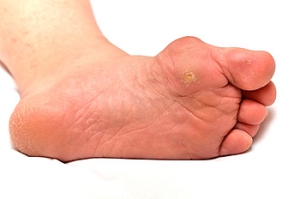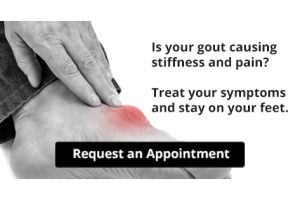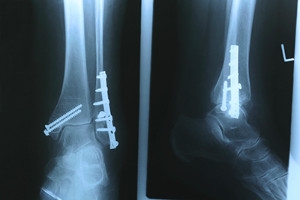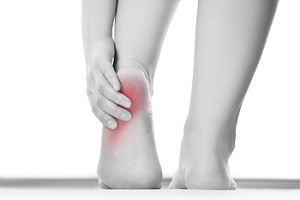
What Are Corns?
A corn is a type of callus or hardened skin that develops on the toes and feet due to consistent friction and pressure. Corns appear as raised hard bumps surrounded by dry flaky skin, and they may be tender and painful to the touch. Since corns are typically caused by friction and pressure, the first step in both prevention and treatment, is to wear comfortable properly-fitted shoes that do not irritate or squeeze your foot. Wearing shoe inserts or custom orthotics can provide cushioning and support for the feet. It is said that soaking and moisturizing the feet may relieve some of the pain caused by corns. However, some painful corns do not improve with at home remedies and need to be examined by a doctor. If you have painful corns on your feet it is suggested that you visit a podiatrist.
Corns can make walking very painful and should be treated immediately. If you have questions regarding your feet and ankles, contact one of our podiatrists of Advanced Ankle & Foot Surgeons. Our doctors will treat your foot and ankle needs.
Corns: What Are They? And How Do You Get Rid of Them?
Corns are thickened areas on the skin that can become painful. They are caused by excessive pressure and friction on the skin. Corns press into the deeper layers of the skin and are usually round in shape.
Ways to Prevent Corns
There are many ways to get rid of painful corns such as:
- Wearing properly fitting shoes that have been measured by a professional
- Wearing shoes that are not sharply pointed or have high heels
- Wearing only shoes that offer support
Treating Corns
Although most corns slowly disappear when the friction or pressure stops, this isn’t always the case. Consult with your podiatrist to determine the best treatment option for your case of corns.
If you have any questions please feel free to contact our office located in O'Fallon, and New Baden, IL . We offer the newest diagnostic and treatment technologies for all your foot and ankle needs.
Corns and Calluses
A corn is a lesion that forms in the skin of the foot, and it is typically circular in shape, small in size, and thick and rough in texture. A corn generally occurs as a result of repeated pressure on the skin; one example of this is the rubbing of a shoe against the skin. Corns differ from calluses in that their central cores are harder in texture.
A corn is a relatively common condition with a wide variety of treatment options. If a corn becomes overly uncomfortable or painful, consult with your podiatrist; he can determine the best method of treatment that is appropriate for you. Corns may return if the underlying cause of its development is not treated or removed. Avoid removing corns at home, as improper removal may cause infection.
A callus, similar to a corn, is an area of skin that has become thickened due to repeated pressure and rubbing. The rubbing causes the skin to create a layer of protective skin, which is the formed callus. Calluses can differ in size between people, and they can also become painful.
Multiple treatments are available for calluses. At-home treatment and removal should be avoided, as this can potentially lead to infection. Your podiatrist can best determine the cause of your calluses and suggest the treatment most appropriate for you.
How Can I Prevent Running Injuries?
 Whether you are new to the sport or have been running for years, injuries to the feet and ankles are common in runners. Luckily, there are preventative measures you can take to avoid some of the most common injuries that affect runners, such as plantar fasciitis, Achilles tendinitis, and stress fractures. It is recommended that you do a warm-up prior to exercising. Doing a warm-up will loosen up your joints, increase blood flow to your muscles, and prepare your nervous system for exercise. Adding strength training to your exercise regimen, specifically exercises targeting the hips, glutes, quads, and feet can also help reduce the risk of injuries. You may want to stretch regularly as well, ideally after every workout, to reduce soreness and maintain your flexibility and range of motion. If you do injure your feet or ankles, it is recommended that you seek medical care from a podiatrist.
Whether you are new to the sport or have been running for years, injuries to the feet and ankles are common in runners. Luckily, there are preventative measures you can take to avoid some of the most common injuries that affect runners, such as plantar fasciitis, Achilles tendinitis, and stress fractures. It is recommended that you do a warm-up prior to exercising. Doing a warm-up will loosen up your joints, increase blood flow to your muscles, and prepare your nervous system for exercise. Adding strength training to your exercise regimen, specifically exercises targeting the hips, glutes, quads, and feet can also help reduce the risk of injuries. You may want to stretch regularly as well, ideally after every workout, to reduce soreness and maintain your flexibility and range of motion. If you do injure your feet or ankles, it is recommended that you seek medical care from a podiatrist.
Exercising your feet regularly with the proper foot wear is a great way to prevent injuries. If you have any concerns about your feet, contact one of our podiatrists of Advanced Ankle & Foot Surgeons. Our doctors will treat your foot and ankle needs.
How to Prevent Running Injuries
Many common running injuries are caused by overuse and overtraining. When the back of the kneecap starts wearing out and starts causing pain in your knee, this is commonly referred to as runner’s knee. Runner’s knee is a decrease in strength in your quadriceps and can occur if you’re not wearing properly fitted or supporting shoes. To prevent runner’s knee, focusing on hip strengthening is a good idea, as well as strengthening your quads to keep the kneecaps aligned.
What Are Some Causes of Running Injuries?
- One cause of a common running injury is called iliotibial band syndrome.
- Plantar fasciitis is also another common injury.
- Stress fractures can occur from overtraining, lack of calcium, or even your running style.
Best Ways to Prevent Running Injuries
- Wear footwear that fits properly and suits your running needs.
- Running shoes are the only protective gear that runners have to safeguard them from injury.
- Make a training schedule. Adding strengthening exercises as well as regular stretching can help keep you strong and limber and can lessen the possibility of injuries.
- Stretching keeps muscles limber; this will help you gain better flexibility.
If you have any questions please feel free to contact our office located in O'Fallon, and New Baden, IL . We offer the newest diagnostic and treatment technologies for all your foot and ankle needs.
How to Prevent Running Injuries
Overtraining and overusing the feet are the main causes of common running injuries. A number of these common injuries are caused by overrunning. Runner’s knee is a condition that is characterized by the back of the kneecap beginning to wear away and cause pain in the knee. This frequently occurs due to either a decrease in strength in the quadriceps muscles or ill-fitting shoes that are lacking in proper support for the inside of the forefoot. Strengthening exercises focusing on the quad muscle and sports orthotics are the usual treatments for those suffering from runner’s knee. Prevention of the condition lies in a focus on hip strengthening and quad-strengthening to keep the kneecap aligned. To help learn the best exercise to heal runner’s knee, one can also undergo physical therapy.
One common injury, called iliotibial band syndrome, is often caused by overtraining. This condition occurs when the iliotibial band gets irritated, creating pain and discomfort in the outside knee area. Plantar fasciitis, another common running injury, also occurs as a result of inflammation and irritation. Plantar fasciitis is an inflammation and irritation of the bone in the foot. A large amount of pain is often experienced due to plantar fasciitis. The condition can be caused by a high arch, improper footwear, tight muscles, or flat feet. It can best be avoided by stretching and wearing appropriate footwear that supports the foot.
Another common injury for runners is stress fractures. These injuries occur due to running style, overtraining, or a lack of calcium. Stress fractures most often occur in several locations in runners, including the inner bone of the leg, the thighbone, the bone at the base of the spine and the bones of the toes. Stress fractures are best prevented by wearing proper footwear and by running on flat and hard surfaces; this will absorb some of the shock created during running.
Aside from overtraining, other causes of common running injuries include ill-fitting footwear, a lack of flexibility and strength, and irregular biomechanics. The best way to avoid running injuries is to prevent them from even occurring. Both iliotibial band syndrome and stress fractures are preventable. The first step that should be taken to prevent running injuries is to only wear footwear that fits properly and that is appropriate for whatever activity you are doing. Running shoes are the only protective gear available to runners that can safeguard them from sustaining injuries. Choosing the right pair of shoes is therefore extremely important. While running shoes are an important factor, it is also important to consider other facets of your running routine such as training schedules, flexibility, and strengthening. These elements should be considered and altered according to your running needs to best maximize your run and minimize the possibility of injury. Careful stretching before and after a run should also be considered to help prevent running injuries. Stretching muscles enables greater flexibility and a lesser chance of sustaining injury.
What is Sever’s Disease?
 Sever's disease is a common ailment experienced by active kids and teenagers, particularly between the ages of 7 and 14. Sever’s disease causes pain when there is stress and inflammation where the Achilles tendon inserts into a growth plate of the heel bone. Because running and jumping causes an increase in stress to the heel bone and growth plate, children and teens who participate in soccer, gymnastics, basketball, tennis, baseball, and football are at a higher risk. If your child is complaining of pain in one or both heels that worsens with running or jumping, they may have Sever’s disease. It is highly recommended to schedule an appointment with a podiatrist. A podiatrist will be able to evaluate the heel bones and take X-rays during the physical examination. If your podiatrist finds your child does have Sever’s disease, they will be able to help treat this condition and manage the pain as well.
Sever's disease is a common ailment experienced by active kids and teenagers, particularly between the ages of 7 and 14. Sever’s disease causes pain when there is stress and inflammation where the Achilles tendon inserts into a growth plate of the heel bone. Because running and jumping causes an increase in stress to the heel bone and growth plate, children and teens who participate in soccer, gymnastics, basketball, tennis, baseball, and football are at a higher risk. If your child is complaining of pain in one or both heels that worsens with running or jumping, they may have Sever’s disease. It is highly recommended to schedule an appointment with a podiatrist. A podiatrist will be able to evaluate the heel bones and take X-rays during the physical examination. If your podiatrist finds your child does have Sever’s disease, they will be able to help treat this condition and manage the pain as well.
Sever's disease often occurs in children and teens. If your child is experiencing foot or ankle pain, see one of our podiatrists from Advanced Ankle & Foot Surgeons. Our doctors can treat your child’s foot and ankle needs.
Sever’s Disease
Sever’s disease is also known as calcaneal apophysitis, which is a medical condition that causes heel pain I none or both feet. The disease is known to affect children between the ages of 8 and 14.
Sever’s disease occurs when part of the child’s heel known as the growth plate (calcaneal epiphysis) is attached to the Achilles tendon. This area can suffer injury when the muscles and tendons of the growing foot do not keep pace with bone growth. Therefore, the constant pain which one experiences at the back of the heel will make the child unable to put any weight on the heel. The child is then forced to walk on their toes.
Symptoms
Acute pain – Pain associated with Sever’s disease is usually felt in the heel when the child engages in physical activity such as walking, jumping and or running.
Highly active – Children who are very active are among the most susceptible in experiencing Sever’s disease, because of the stress and tension placed on their feet.
If you have any questions, please feel free to contact our office located in O'Fallon, and New Baden, IL . We offer the newest diagnostic and treatment technologies for all your foot and ankle injuries.
Sever's Disease
Sever's disease, also known as calcaneal apophysitis, is a medical condition that causes heel pain in children’s feet while they’re growing. Sever's disease occurs most commonly in boys and girls between the ages of 8 and 14.
Sever's disease occurs when the child’s growth plate, or the calcaneal epiphysis, an area attached to the Achilles tendon, is injured or when the muscles and tendons of the growing foot do not keep pace with bone growth. The result is constant pain experienced at the back of the heel and the inability to put any weight on the heel. This forces the child to bear weight on their toes while walking. When a toe gait develops, the child must change the way they walk to avoid placing weight on the painful heel. If this is not properly addressed, this can lead to further developmental problems.
The most common symptom of Sever's disease is acute pain felt in the heel when a child engages in physical activity such as walking, jumping or running. Children who are active athletes are among the group most susceptible to experiencing Sever's disease. This is due to the extreme stress and tension placed on their growing feet. The rolling movement of the foot during walking or running and obesity are both additional conditions linked to causing Sever's disease.
The first step in treating Sever's disease is to rest the foot and leg and avoid physical activity. Over the counter pain-relieving and anti-inflammatory medications can be helpful for reducing the amount of heel pain. A child with Sever's disease should also wear shoes that properly support the heel and the arch of the foot. Consider purchasing orthotic shoe inserts which can help support the heel and foot while it is healing. Most patients with Sever's disease symptoms report an eventual elimination of heel pain after wearing orthotic insoles that support the affected heel.
Sever's disease may affect either one heel or both. It is important for a child experiencing heel pain to be examined by a foot doctor who can apply the squeeze test. The squeeze test compresses both sides of the heel in order to determine if there is intense pain. Discourage any child diagnosed with Sever's disease from going barefoot as this can intensify the problem. Apply ice packs to the affected painful heel two or three times a day for pain relief.
Exercises that help stretch the calf muscles and hamstrings are effective at treating Sever's disease. An exercise known as foot curling has also proven to be very effective at treating Sever's disease. When foot curling, the foot is pointed away from the body, then curled toward the body to help stretch the muscles. The curling exercise should be done in sets of 10 or 20 repetitions and repeated several times throughout the day.
Treatment methods can continue for at least 2 weeks and as long as 2 months before the heel pain completely disappears. A child can continue doing daily stretching exercises for the legs and feet to prevent Sever’s disease from returning.
What Are Stress Fractures?
 A stress fracture is a tiny crack in the bone that occurs because too much stress was placed on the foot. Stress fractures don’t usually occur because of a particular trauma, but rather they gradually develop over time. Some causes of stress fractures include repetitive high-impact activities, increased training, low bone density, and poor nutrition. Most stress fractures can be diagnosed with x-rays, but an MRI or CT scan may be necessary for smaller and newer stress fractures. Upon the discovery of a stress fracture, a cast or walking boot may be necessary. Generally, stress fractures take around 4-6 weeks to heal, and a slow return to your normal activity will be needed. If you are feeling a gradual increase of pain in the feet that you believe may be a stress fracture, please consult with a podiatrist for a proper diagnosis.
A stress fracture is a tiny crack in the bone that occurs because too much stress was placed on the foot. Stress fractures don’t usually occur because of a particular trauma, but rather they gradually develop over time. Some causes of stress fractures include repetitive high-impact activities, increased training, low bone density, and poor nutrition. Most stress fractures can be diagnosed with x-rays, but an MRI or CT scan may be necessary for smaller and newer stress fractures. Upon the discovery of a stress fracture, a cast or walking boot may be necessary. Generally, stress fractures take around 4-6 weeks to heal, and a slow return to your normal activity will be needed. If you are feeling a gradual increase of pain in the feet that you believe may be a stress fracture, please consult with a podiatrist for a proper diagnosis.
Stress fractures occur when there is a tiny crack within a bone. To learn more, contact one of our podiatrists from Advanced Ankle & Foot Surgeons. Our doctors can provide the care you need to keep you pain free and on your feet.
How Are They Caused?
Stress fractures are the result of repetitive force being placed on the bone. Since the lower leg and feet often carry most of the body’s weight, stress fractures are likely to occur in these areas. If you rush into a new exercise, you are more likely to develop a stress fracture since you are starting too much, too soon. Pain resulting from stress fractures may go unnoticed at first, however it may start to worsen over time.
Risk Factors
- Gender – They are more commonly found in women compared to men.
- Foot Problems – People with unusual arches in their feet are more likely to develop stress fractures.
- Certain Sports – Dancers, gymnasts, tennis players, runners, and basketball players are more likely to develop stress fractures.
- Lack of Nutrients – A lack of vitamin D and calcium may weaken the bones and make you more prone to stress fractures
- Weak Bones – Osteoporosis can weaken the bones therefore resulting in stress fractures
Stress fractures do not always heal properly, so it is important that you seek help from a podiatrist if you suspect you may have one. Ignoring your stress fracture may cause it to worsen, and you may develop chronic pain as well as additional fractures.
If you have any questions, please feel free to contact our office located in O'Fallon, and New Baden, IL . We offer the newest diagnostic and treatment technologies for all your foot care needs.
Stress Fractures of the Foot and Ankle
Our bones are important aspects of our body and they are constantly changing. The heavier the workload for a bone, the more likely it is that calcium will be placed in it. When a bone isn’t used often, there won’t be much calcium within it. When stress from repetitive loads prevent the bone from being able to repair itself, cracks will start to form. Stress fractures are defined as cracks in a bone that result from repetitive force, such as overuse.
The most common cause of stress fractures is a sudden increase in intensity and duration of physical activity. For example, if you begin to run long distances without working your way into doing so, you will be more likely to develop a stress fracture.
Common symptoms of stress fractures are pain and swelling near the weight bearing area on the injured bone. When initial x-rays are performed, it is possible that the fracture will not show up. However, once the stress on the area continues, the damage will increase, and the fracture will be severe enough to show up on an x-ray. Certain parts of the foot are more likely to develop stress fractures than others. Areas that typically have these fractures are: the metatarsals, the navicular bone, the calcaneus, tibia, and fibula.
Since women are at an increased risk of developing osteoporosis, they are twice as likely as men to sustain a stress fracture. Additionally, old age causes a decrease in bone mineral density which is why elderly people are also likely to develop these fractures.
It is important for you to be professionally diagnosed by a podiatrist if you suspect you have a stress fracture, because there are other injuries that can easily be mistaken for a fracture. Sprains, strains, shin splints, plantar fasciitis, and Morton’s neuroma can all easily be mistaken for stress fractures in the foot. Your podiatrist will likely ask you a series of questions to determine what type of pain you are experiencing. These questions will help your doctor identify whether you have a stress fracture.
The best method of treatment for a stress fracture is rest. Additionally, a walking boot, cast, or crutches, will help rest the area that is injured. The typical healing time for stress fractures is 4-12 weeks, however this depends on which bone is involved.
Older Adults and Heel Pain
 There are several bones, muscles, ligaments, and joints that each foot consists of. The feet absorb the weight of the body, and heel pain is experienced by many patients. The shape of the foot may change as the aging process occurs, so one may be vulnerable to developing specific foot conditions. These can include heel spurs, plantar fasciitis, and ankle injuries. It is beneficial to wear shoes that fit correctly in addition to having adequate cushioning in the heel area. There may be existing medical conditions that can lead to heel pain, consisting of certain types of arthritis, or obesity. Research as indicated it is beneficial to perform stretches that can help to loosen the muscles and tendons surrounding the heel, and this may help to relieve a portion of heel pain. If you have any type of heel pain, please consult with a podiatrist who can properly diagnose and treat this ailment.
There are several bones, muscles, ligaments, and joints that each foot consists of. The feet absorb the weight of the body, and heel pain is experienced by many patients. The shape of the foot may change as the aging process occurs, so one may be vulnerable to developing specific foot conditions. These can include heel spurs, plantar fasciitis, and ankle injuries. It is beneficial to wear shoes that fit correctly in addition to having adequate cushioning in the heel area. There may be existing medical conditions that can lead to heel pain, consisting of certain types of arthritis, or obesity. Research as indicated it is beneficial to perform stretches that can help to loosen the muscles and tendons surrounding the heel, and this may help to relieve a portion of heel pain. If you have any type of heel pain, please consult with a podiatrist who can properly diagnose and treat this ailment.
Many people suffer from bouts of heel pain. For more information, contact one of our podiatrists of Advanced Ankle & Foot Surgeons. Our doctors can provide the care you need to keep you pain-free and on your feet.
Causes of Heel Pain
Heel pain is often associated with plantar fasciitis. The plantar fascia is a band of tissues that extends along the bottom of the foot. A rip or tear in this ligament can cause inflammation of the tissue.
Achilles tendonitis is another cause of heel pain. Inflammation of the Achilles tendon will cause pain from fractures and muscle tearing. Lack of flexibility is also another symptom.
Heel spurs are another cause of pain. When the tissues of the plantar fascia undergo a great deal of stress, it can lead to ligament separation from the heel bone, causing heel spurs.
Why Might Heel Pain Occur?
- Wearing ill-fitting shoes
- Wearing non-supportive shoes
- Weight change
- Excessive running
Treatments
Heel pain should be treated as soon as possible for immediate results. Keeping your feet in a stress-free environment will help. If you suffer from Achilles tendonitis or plantar fasciitis, applying ice will reduce the swelling. Stretching before an exercise like running will help the muscles. Using all these tips will help make heel pain a condition of the past.
If you have any questions please contact our office located in O'Fallon, and New Baden, IL . We offer the newest diagnostic and treatment technologies for all your foot and ankle needs.








